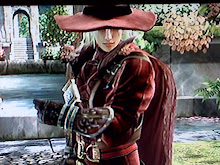Project Soul takes a bold step in a different direction for the series with new mechanics, new characters, and a long-overdue, refined multiplayer system. For longtime fans, the loss of favorite characters, increased gameplay speed and strategy, and hackneyed story mode may be a turnoff for those who aren’t hardcore fans.
I’ve been a loyal SoulCalibur fan since the first one (not Soul Edge, unfortunately), so I was giddy with anticipation when I learned that number 4 wasn’t going to be the last one. The SoulCalibur series has been top-of-the-line in terms of weapon-based fighting; although is simple enough for anyone to pick up and play, something can be said about mastering the nuances of the game mechanics. Soulcalibur V is no different.
It’s clear that Project Soul listened to their fans on this one. Multiplayer is no longer just searching for a lobby to join; a much-needed overhaul has been done, with the return of ranked matches, player lobbies, and the addition of the “Global Colloseo”, a great city-based collection of servers that allow you to join tournaments, create player lounges, and text/voice chat with everyone in the lobby.
Soulcalibur V is currently available on both the XBox 360 and PlayStation 3.
Graphics: 8/10
I’m not really seeing a big change between the graphics of IV and V, but you shouldn’t have to fix what isn’t broken. Once again, characters, stages, and weapon effects are brilliantly rendered on both platforms. People do not play this game because it’s pretty, though. I know I don’t.
The biggest improvement, as far as I can see, is the character creation mode. You can customize pretty much everything this time around; even your weapon’s color and trail. It opens up a huge new venue for creativity, with the addition of tattoos, stickers, and miscellaneous trinkets to add to your fighter.
Story: 5/10
Set 17 years after the previous game, the story is no longer centered around Siegfried and Nightmare. Instead, a new duality arises from Sophitia’s grown children, brother and sister Patroklos and Pyrrha. Sophitia is now deceased. (Also, unfortunately, Cassandra is nowhere to be found, which I am thoroughly disappointed with considering that she was my best character in IV.)
The single-player story campaign centers around these two; Patroklos, now a holy warrior, is searching for his lost sister, who was abducted by a malfested girl with a ring-blade. (Guess who.) Through the story mode, the new characters to the series are introduced, but no explanation is given to the absence of the characters that were in IV.
This mode is really nothing to write home about, especially since it’s a good crash-course in a few of the new fighting styles. However, most of the latter part of the story, you are forced to use a style identical to Setsuka’s from IV. Patroklos’ other form makes a good replacement for her.
Gameplay: 9/10
Soulcalibur’s fighting system centers around the 8-way run mechanic, which allows your fighter to move around the arena in any direction you choose while still focusing on your opponent. Project Soul made sure that the finer points of this mechanic were improved upon; the quick step (a sideways dash to avoid vertical attacks) has been emphasized in both animation and character movesets.
SCV also does away with the high/mid/low armor break and soul gauge system in favor of just an all-over armor gauge that depletes as attacks are guarded; at any point, if you guard too powerful a hit, you are reduced to your undergarments. The “soul crush” from the previous game has changed into the “guard burst”, and it has almost the same effect.
Following in the popularity of other fighting games’ “super meters”, your fighter’s soul gauge now fills up as you play, to two levels. Actions with the soul gauge are linked to the A+B+K button and use up a certain amount of the meter. Using the A+B+K button combination after specific moves turns them into a “Brave Edge” move, which either gives it higher damage, more hits, or guard break properties. The critical finish round-ending move from the last game has been replaced with the Critical Edge, which for every character is two forward sweeps (think a Street Fighter shinkuu-hadoken) and the A+B+K button. Both of these Edge moves are a great addition to establishing combos, and adding them to a player’s repertoire of mix-ups makes for a very fast-paced and offense-oriented fight. As further proof of this, the importance of the Guard Impact has been diminished; it can now only be accomplished by using your soul gauge.
Overall: 8/10
I miss Talim, Setsuka, Cassandra, Yunsung, and Seong Mi-na. I’ll get over it, though. If you’ve played Soulcalibur at all and are wondering whether or not you should get this game, stop wondering. Go ahead and get it. It’s got huge replay value, the online multiplayer is now up to fighting game standards, and the characters you can create have almost no limits. It’s not the best starting point for people who are new to the series, but after picking it up, you’ll realize why it’s gone through so many installments.






No comments:
Post a Comment